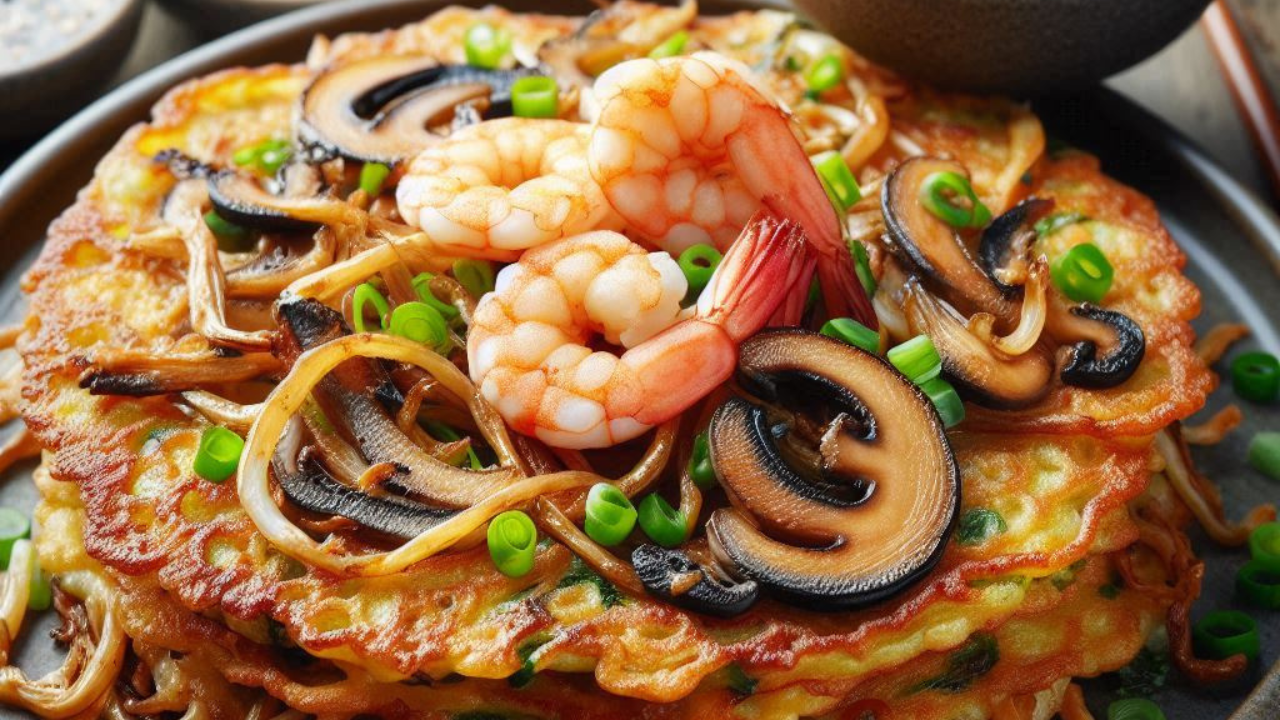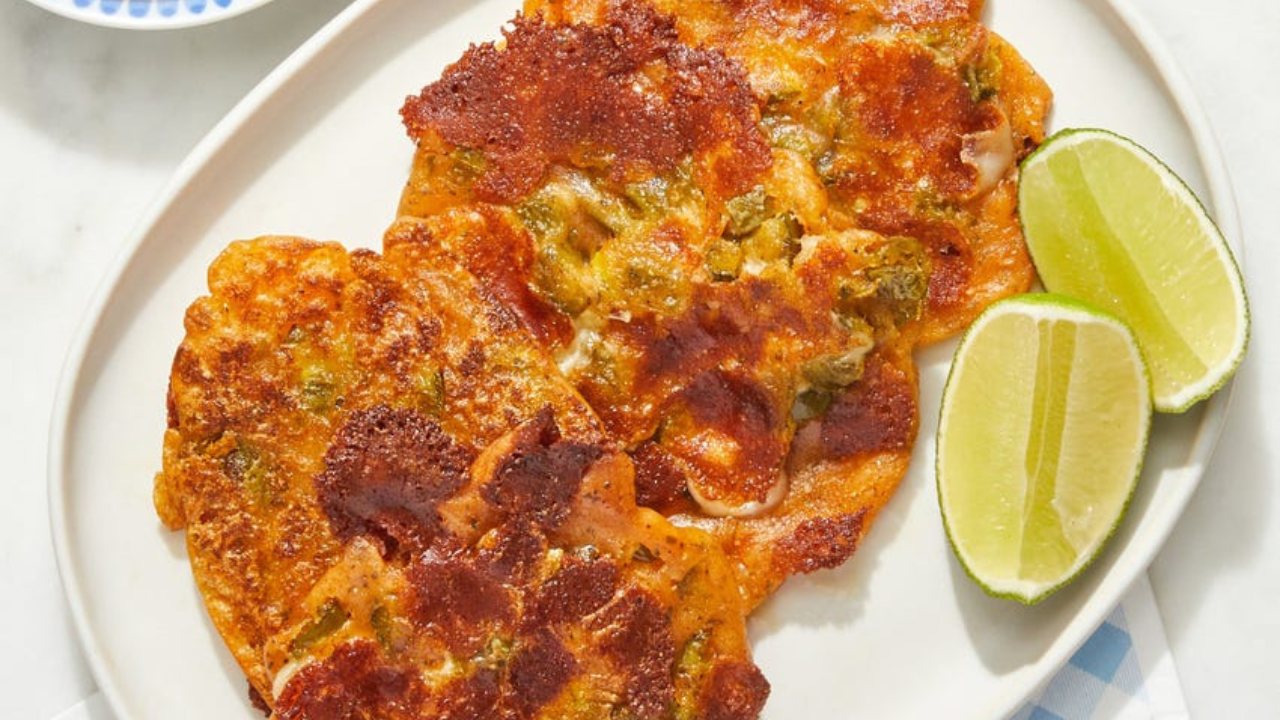Introduction
Mushroom and shrimp pancakes, known as “Pajeon” in Korean cuisine, are a delightful and savory treat that captures the essence of Korean street food. These pancakes are not only delicious but also versatile, allowing for a range of ingredients and flavors to be incorporated. In this comprehensive description, we will explore the history, ingredients, preparation methods, and cultural significance of mushroom and shrimp pajeon.
Historical Background
Pajeon has a long-standing history in Korean cuisine, dating back to the Joseon Dynasty (1392-1897). It is a type of “jeon,” which refers to a variety of Korean pancakes made with different ingredients. The name “Pajeon” specifically refers to a pancake that includes green onions (“pa” in Korean) as a primary ingredient. Over time, various versions of pajeon have emerged, incorporating ingredients like seafood, vegetables, and mushrooms to create unique and flavorful variations.

Ingredients
The beauty of pajeon lies in its simplicity and the freshness of its ingredients. The primary components for mushroom and shrimp pajeon include:
- Green Onions (Scallions): These form the base of the pancake, providing a mild onion flavor and a satisfying crunch.
- Shrimp: Fresh shrimp adds a sweet and briny taste to the pancake. It is often chopped into small pieces to distribute evenly throughout the batter.
- Mushrooms: Various types of mushrooms can be used, such as shiitake, oyster, or button mushrooms. They add an earthy flavor and a meaty texture.
- Flour and Water: A simple batter made from all-purpose flour and water acts as the binding agent. Some recipes may include a bit of rice flour for added crispiness.
- Eggs: Eggs are mixed into the batter to provide structure and help bind the ingredients together.
- Seasonings: Soy sauce, salt, and pepper are commonly used to season the batter. Some recipes may also include a touch of sugar for balance.
- Oil: Vegetable oil or sesame oil is used for frying the pancakes, giving them a crispy exterior.
Preparation
Watch the Full Recipe Video:
Making mushroom and shrimp pajeon involves several straightforward steps:
- Preparing the Ingredients:
- Clean and slice the mushrooms.
- Peel and devein the shrimp, then cut into small pieces..
- Wash and chop the green onions into 2-3 inch lengths.
- Making the Batter:
- In a mixing bowl, combine all-purpose flour, water, and eggs to form a smooth batter.
- Add soy sauce, salt and pepper to taste.
- Fold in the chopped shrimp, mushrooms, and green onions, ensuring they are evenly distributed in the batter.
- Cooking the Pancakes:
- Heat a generous amount of oil in a large non-stick skillet over medium-high heat.
- Pour a ladleful of batter into the skillet, spreading it out evenly to form a pancake. The thickness can be adjusted based on personal preference.
- Cook for 3-4 minutes on each side, or until the pancake is golden brown and crispy. Adjust heat as needed to avoid burns.
- Repeat with the remaining batter, adding more oil to the skillet as needed.
- Serving:
- Once cooked, transfer the pancakes to a plate lined with paper towels to drain excess oil.
- Cut the pancakes into bite-sized pieces and serve hot with a dipping sauce.

Dipping Sauce
The dipping sauce is a crucial accompaniment to pajeon, enhancing its flavors. A traditional dipping sauce can be made by mixing soy sauce, rice vinegar, sesame oil, minced garlic, and a touch of sugar. For added heat, you can include chili flakes or a small amount of gochujang (Korean red chili paste).
Variations
Pajeon is a versatile dish, and several variations exist:
- Seafood Pajeon: Along with shrimp, other seafood like squid, clams, or mussels can be added for a more diverse flavor profile.
- Vegetarian Pajeon: Omit the shrimp and add more vegetables like zucchini, carrots, or bell peppers for a vegetarian-friendly version.
- Kimchi Pajeon: Incorporating chopped kimchi into the batter adds a spicy and tangy twist to the traditional pajeon.
- Buchimgae: This is a broader term for Korean pancakes, and you can experiment with different ingredients like potatoes, chives, or even tofu.
Cultural Significance
Pajeon holds a special place in Korean culture and is often associated with comfort and communal dining. It is a popular dish during celebrations and family gatherings. Pajeon is also commonly enjoyed on rainy days, as the sound of sizzling pancakes is said to mimic the sound of falling rain, creating a cozy and nostalgic atmosphere.
Nutritional Value
Mushroom and shrimp pajeon is not only delicious but also nutritious. It provides a good balance of protein from the shrimp and eggs, vitamins and minerals from the mushrooms and green onions, and carbohydrates from the flour. To make it healthier, you can use whole grain flour or add more vegetables to the batter.
Pairing Suggestions
Pajeon pairs well with a variety of Korean dishes and beverages:

- Makgeolli: This traditional Korean rice wine is a classic pairing with pajeon. Its slightly sweet and tangy flavor complements the savory pancake perfectly.
- Kimchi: A side of kimchi adds a spicy and fermented contrast to the pajeon.
- Korean BBQ: Pajeon can be served as an appetizer or side dish with Korean BBQ, enhancing the overall dining experience.
- Soup: A bowl of hot soup, like doenjang jjigae (soybean paste stew) or kimchi jjigae (kimchi stew), can be a comforting accompaniment.
Tips for Perfect Pajeon
- Dough consistency: make sure the dough is not too thick or too thin
- Crispy Texture: For extra crispiness, you can add a small amount of rice flour to the batter or cook the pancakes in a combination of vegetable oil and sesame oil.
- Even Cooking: Spread the ingredients evenly in the batter and in the skillet to ensure uniform cooking.
- Temperature Control: Cook over medium-high heat, adjusting as necessary to prevent burning while achieving a golden-brown crust.
FAQs:
1. What is Pajeon?
Pajeon is a Korean savory pancake made primarily with green onions (scallions), hence its name “pa” meaning green onion in Korean and “jeon” referring to a type of pancake. Mushroom and shrimp are popular additions, creating a flavorful and hearty dish.
2. What ingredients do I need to make Mushroom & Shrimp Pajeon?
The key ingredients include:
- Green onions (scallions)
- Shrimp
- Mushrooms (such as shiitake, oyster, or button)
- All-purpose flour
- Water
- Eggs
- Soy sauce
- Salt and pepper
- Vegetable oil or sesame oil for frying
3. How do I prepare the shrimp and mushrooms for Pajeon?

- Shrimp: Peel, devein, and chop the shrimp into small pieces to ensure they cook evenly and distribute well in the batter.
- Mushrooms: Clean and slice the mushrooms thinly. You can use a variety of mushrooms for different textures and flavors.
4. Can I make Pajeon without eggs?
Yes, you can make a vegan version of Pajeon by omitting the eggs. To replace eggs, you can use a mixture of water and a tablespoon of ground flaxseeds or chia seeds soaked in water. This will help bind the ingredients together.
5. What type of flour is best for making Pajeon?
All-purpose flour is commonly used for making Pajeon. Some recipes may also include rice flour to enhance the crispiness of the pancake.
6. How do I make the batter for Pajeon?
To make the batter, mix all-purpose flour, water, and eggs until smooth. Season with soy sauce, salt, and pepper. The consistency should be similar to pancake batter, not too thick or too thin.
7. How do I cook Mushroom & Shrimp Pajeon?
- Heat oil in a large non-stick skillet over medium-high heat.
- Pour a ladleful of batter into the skillet, spreading it out evenly to form a pancake.
- Cook for 3-4 minutes on each side, or until golden brown and crispy.
- Repeat with the remaining batter, adding more oil as needed.
8. What dipping sauce pairs well with Pajeon?
A traditional dipping sauce can be made by mixing soy sauce, rice vinegar, sesame oil, minced garlic, and a touch of sugar. For added heat, you can include chili flakes or gochujang (Korean red chili paste).
9. Can I make Pajeon in advance?

Pajeon is best enjoyed fresh and hot, but you can prepare the batter and chop the ingredients in advance. Cook the pancakes just before serving for the best texture.
10. Are there any variations of Pajeon?
Yes, there are several variations:
- Seafood Pajeon: Add other seafood like squid, clams, or mussels.
- Vegetarian Pajeon: Use more vegetables like zucchini, carrots, or bell peppers.
- Kimchi Pajeon: Add chopped kimchi for a spicy and tangy twist.
11. What is the cultural significance of Pajeon in Korea?
Pajeon is a popular comfort food in Korea, often enjoyed during celebrations, family gatherings, and rainy days. The sound of sizzling pancakes is said to mimic the sound of falling rain, creating a cozy and nostalgic atmosphere.
12. How do I store and reheat leftover Pajeon?
Store leftover Pajeon in an airtight container in the refrigerator for up to 2 days. Reheat in a skillet over medium heat until warmed through and crispy, or use an oven or toaster oven for reheating.
13. Is Pajeon healthy?
Pajeon can be a nutritious dish, providing protein from shrimp and eggs, vitamins and minerals from vegetables, and carbohydrates from flour. To make it healthier, use whole grain flour and add more vegetables.
14. Can I freeze Pajeon?
Yes, you can freeze cooked Pajeon. Place the pancakes in a single layer on a baking sheet to freeze, then transfer to a freezer-safe container or bag. Reheat in a skillet or oven directly from frozen until crispy and heated through.
15. What beverages pair well with Pajeon?

Pajeon pairs well with:
- Makgeolli: A traditional Korean rice wine with a slightly sweet and tangy flavor.
- Soju: A clear, distilled Korean liquor.
- Beer: A light, crisp beer complements the savory flavors of Pajeon.
16. Can I customize the ingredients in Pajeon?
Absolutely! Pajeon is versatile, and you can customize the ingredients based on your preferences. Experiment with different vegetables, seafood, and seasonings to create your perfect Pajeon.
17. Why is Pajeon considered a rainy day food in Korea?
The sizzling sound of Pajeon cooking is said to resemble the sound of falling rain, making it a popular dish to enjoy on rainy days. It creates a warm and cozy atmosphere, perfect for staying indoors.
18. How do I make my Pajeon extra crispy?
To achieve extra crispiness, use a combination of all-purpose flour and rice flour in the batter. Additionally, ensure the oil is hot enough before adding the batter and avoid overcrowding the skillet.
19. What can I serve with Pajeon?

Pajeon can be served with a variety of side dishes, such as kimchi, pickled vegetables, or a simple salad. It also makes a great appetizer or side dish for a larger Korean meal.
20. Is Pajeon gluten-free?
Traditional Pajeon is made with all-purpose flour, which contains gluten. However, you can make a gluten-free version by using a gluten-free flour blend or rice flour as a substitute.
Conclusion:
Mushroom and shrimp pancakes (pajeon) are a delightful and versatile dish that embodies the rich culinary traditions of Korea. With its crispy exterior, tender interior, and a harmonious blend of flavors, pajeon is a crowd-pleaser that can be enjoyed on various occasions. Whether served as an appetizer, a main course, or a snack, pajeon offers a taste of Korean culture and a satisfying dining experience. By following the simple steps and tips outlined above, you can create this delectable dish in your own kitchen and savor the flavors of Korea.

